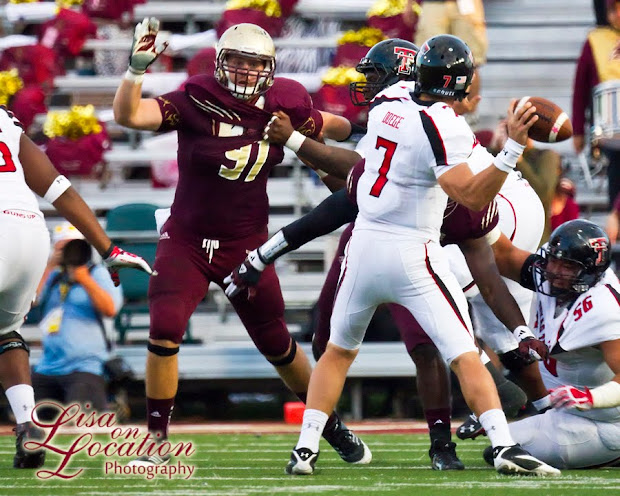Way back when, 20 years or so now, Lisa got her start in photojournalism photographing sports. She stalked the sidelines of Texas A&M football games, and later covered high school sports for various newspapers. She got pretty good at it. Keep in mind this was back in the days of film cameras, 36 shots to a roll, most of which she developed herself in the dark room. Pretty challenging stuff, even though many photographers made their living at it. I (being Jayme, Lisa's long-suffering sidekick) came to photography much later in life, after the digital revolution, and never had an opportunity to shoot sports. I played around with it a few years back, when I first got into photography, and while digital makes it a lot easier to start out, it's still an incredibly challenging art. The action moves so fast, you have to psyche yourself to shoot what's about to happen, and anticipate accordingly. If you wait until you see something interesting, you're going to miss it.
The Texas State University Bobcats hosted the Texas Tech Red Raiders in the newly-expanded Bobcat Stadium Saturday, in their first home game as a Division I-FBS team (that's Division I-A for old-school folks like me). Since I had to be on hand to deal with media if anything newsworthy happened off the field (the crowd of 30,000-plus being by far the largest ever to descend upon San Marcos) I decided to use the opportunity to practice my sports photography skills. Specifically, I saw it as an opportunity to try out my Canon FD 500mm f/8 reflex lens in the field. Lisa got me that old Canon mirror lens last Christmas, and I converted it to work on modern Canon cameras. The lens is manual-focus only, though, so even with some electronic enhancements, I expected it to be quite the challenge to shoot with.
You know what? I was right. A 500mm manual focus lens is very difficult to shoot action with. The fact that professional sports photographers 30 years ago used this kind of lens regularly is simply amazing to me. I suppose it's just a matter of practice, practice, practice until focusing become second nature, but still. Fortunately for me, digital is a great equalizer, and I was able to see what worked and what didn't immediately and adjust on the fly. I got several decent keepers, and threw away far, far more with missed focus and bad framing.
I can also assure you that a 500mm lens has a long reach. Which is great when you're shooting something far away, but once the action moves closer, it's challenging to make everything fit within the frame. Most of the images I'm sharing here were taken with the mirror lens, but the first, seventh and eighth were taken with traditional telephoto zooms. One way to identify photos taken with a mirror lens is to look for out-of-focus highlights that look like donuts. That's always a tell-tale sign.
It's fun to get out and try something outside of my comfort zone. I'm not anywhere close to making the cover of Sports Illustrated, but with enough practice I could get there. I could see my improvement from the start of the first quarter to the final seconds, and the journey is half the fun, right?
Lisa On Location Photography









No comments:
Post a Comment